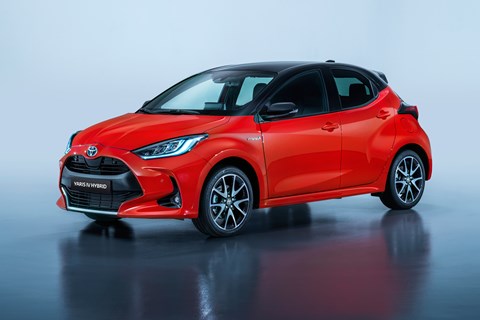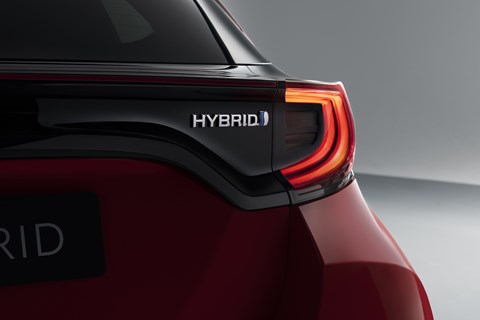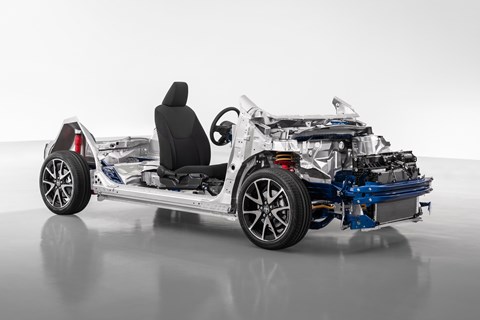► New Toyota Yaris hatch
► Supermini on sale in Sept 2020
► New TNGA platform underpins it
This is the all-new Toyota Yaris, first revealed in October 2019 at the 2019 Tokyo motor show. Although we’ve now seen the latest Toyota mini, customer deliveries won’t begin for this rebooted Ford Fiesta, Renault Clio and Vauxhall Corsa rival until September 2020.
That follows its European debut at the 2020 Geneva motor show, so the full Euro specs and details are now emerging.
Why the long wait for the new Toyota Yaris?
It seems that Toyota’s so keen to show off what it’s got up its sleeve that the European-spec Yaris has been shown much earlier than normal – well ahead of the 50mm narrower Japanese market version, which incidentally adopts the Yaris name, too, replacing Vitz.

There’s definitely risk attached with such an approach – sales of the outgoing Mk3 Yaris, already eight years old and subject to more cosmetic work of late than Simon Cowell, could plummet. However, given the verve of the newcomer’s styling, as well as an all-new hybrid package, Toyota’s hoping that it’ll keep brand loyalists within the fold and persuade supermini buyers away from the usual suspects’ showrooms.
Time will tell. The more immediate downside is that much of the technical data is weeks away from being firmed up, so bear with us on that score…
It certainly looks very different
Toyota’s top brass were visibly buoyed by the Mk4’s prospects at its unveiling, most immediately because of how it looks. Gone are the tallboy proportions of Yarises of yore, replaced by a lower, lither supermini stance: it’s 5mm shorter, 40mm lower and 50mm broader for a squat, purposeful appearance. This all makes a more obvious space for a B-segment SUV to be sold alongside it in future, no?
Up front is a lower interpretation of Toyota’s current nose design, while the Yaris’s flanks are far swoopier than before – there are hints of the boomerang-shaped blisters of the original Aygo around the rear haunches, while the tail’s dominated by a gloss black panel linking the tail lights.

Optional two-tone paint schemes, LED headlamps and alloys up to 17 inches complete the look.
All good so far, then…
It’s a successful reinvention of the 20-year-old nameplate, and while it looks daring from some angles, it’s a little awkward from others – side-on, for instance the rear doors look too short, hinting at limited space in the back seat. There will be no three-door Toyota Yaris this time round.
We’ve not yet been granted access to sit inside the new Yaris, but a nosy through the back windows suggests rear legroom will be adequate (its wheelbase has been stretched by 50mm), but a combination of the rising shoulder line and thick rear pillars conspires to make it rather dark in there.
What about the bits of the new 2020 Toyota Yaris we can’t see?
Toyota-watchers will have noted the relentless roll-out of its much-vaunted TNGA flexible architecture and under the Yaris is a new iteration of it: GA-B. Employing the same philosophies as the larger versions, it’s been tailored for the packaging requirements of a B-segment car, with particular emphasis on increasing torsional rigidity to a new segment standard (up 35% over the Mk3), despite being 20kg lighter model-for-model.

Not only this, but a lower centre-of-gravity should bestow it with fine handling – evidenced on other TNGA models – while the stiffer structure allows the damping to be softened, improving ride comfort.
And, as if to reinforce the potential dynamism of the Yaris, Toyota’s seen fit to adjust the steering wheel angle to be six degrees more vertical, as well as position the hub centre 77mm nearer the driver, who incidentally also sits 36mm lower.
That bodes well for a new GRMN hot hatch!
Whether it’s called that, or simply GR Yaris, a high-performance version is a dead cert for 2021, coinciding with the Mk4’s competition debut in the WRC arena. Win on Sunday, sell on Monday…
It’s unlikely to be quite the frenzied little upstart the recently departed Mk3 GRMN was, nor is it set to be a limited production model either, but both of these factors should make it considerably cheaper than its predecessor, while hopefully still being a hoot to pilot.
Forget that, though – hybrids are where it’s at, surely?
Indeed. In fact, Toyota expects the vast bulk of all new Yarises sold will be hybrid-powered. The on-paper potential of the fourth-generation powertrain is very impressive.
Although there are no official performance or efficiency figures to coo over yet, the all-new 1.5-litre three-pot and overhauled, more compact electrical transaxle is said to be at least 15% more powerful than today’s model, while being over 20% more economical.
Toyota claims the self-charging system – its turn of phrase, not ours – can be driven in fully electric mode for up to 80% of the time on a typical European urban journey, while on more open roads 80mph can be topped before the engine kicks into life. Efficiency’s further boosted by a new lithium-ion battery pack that’s housed under the rear seats, which tips the scales some 27% lighter than the Mk3’s version.

Perhaps more tellingly were the engineers’ references to a ‘more natural driving experience’, using a greater degree of electrical energy under harder acceleration than before to quell the engine’s need to rev so frantically. This rather flies in the face of previous assertions that hybrid customers rarely complained about the mooing driveline, but it’s a tacit acknowledgement that its hybrids will need to be normalised if significant numbers of conquest sales are to be achieved.
Other, non-hybrid engines are available, but it’s not yet certain whether both will make it to these shores. Both are non-turbo triples: a 1.0-litre with a five-speed manual and a 1.5- with the choice of a six-speed manual or a CVT automatic.
Super-safe supermini
Lest we forget, the second-generation Yaris scored the first five-star crash-test result for a small hatch in Euro NCAP testing. In the intervening 15 years the test standards have evolved, meaning cars have to be bristling with kit to have a hope of achieving the same high marks.
Toyota’s confident it will repeat history with the Mk4 courtesy of a standard-fit central airbag that bursts out from between the front seats to stop occupants colliding with each other in the event of a heavy impact.
Other kit will also be available under the Toyota Safety Sense umbrella, including lane-keeping tech, blindspot monitoring, autonomous emergency braking and a head-up display system.
Plus there’s good news for those who trip up when using Toyota’s fiddly home-grown infotainment system – Android Auto and Apple CarPlay are also both available from launch. Hallelujah.

How much will the Mk4 Yaris cost?
That’s a great unknown for now, with continued Brexit uncertainty and the fact that the Yaris will be imported from France – only its bigger brother, the Corolla, is built on these shores now, at the Burnaston factory in Derbyshire.
But assuming it’s a steady, economically sensible ride, a small increase over Mk3 prices is to be expected when orders open in late spring 2020.
Check out our Toyota reviews